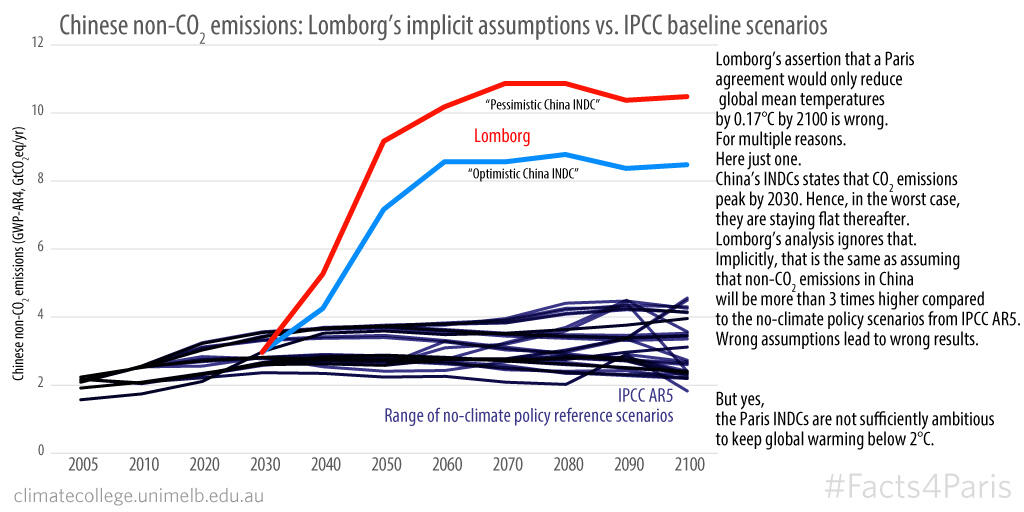Facts4Paris: Lomborg. Wrong again.

Reported in The Australian today (Paris pledges ‘wishful thinking, not optimism’: Bjorn Lomborg), climate dissident Bjorn Lomborg has published findings suggesting that the Paris agreement will reduce global mean temperatures in 2100 by only 0.17°C.
To make this finding he used the climate model that we co-developed: MAGICC, so we know it well. The thing about climate models, in fact any models, is that what you get out is only as trustworthy and as reliable as the assumptions you make and therefore on what you put in. It's the old adage of "garbage-in, garbage-out" (GIGO for short).
So let's examine what Lomborg put into MAGICC so that we can decide whether it's garbage.
Lomborg outlines two cases, an optimistic case and a pessimistic case. In the optimistic case, Lomborg assumes that countries maintain their commitments after the target end-date lapses (as flat emissions, not reductions). In the pessimistic scenario he assumes that they do not (emissions rise in line with earlier trends).
Importantly, he explicitly disregards any mid- to long-term policies. According to political scientist Lomborg, the year 2030 is as far as policy-making can go. Yet according to the atmosphere, the biosphere, the hydrosphere, the lithosphere and the cryosphere, temperatures in 2100 are largely dependent on what happens after 2030. See our earlier Facts4Paris here for illustration of the importance of post-2030 assumptions.
Lomborg's study has an almost exclusive focus on the US, the EU and China. So let's see what his 2030 assumption means for these three countries:
- For the US, Lomborg assumes in the optimistic scenario that after 2030, the US continues to emit at the same rate as in 2030. This ignores that the US has flagged an emissions reduction target by 2050 of 80%. In the pessimistic scenario, US emissions go into a hyper-drive increase. This ignores the simple fact that the US 2030 target will put the country on certain trajectory of change (technological, economic etc) the benefits of which should continue beyond 2030. It is non-sensical to assume that emissions will simply blow out when the 2030 deadline rolls around.
- For the EU, in both the optimistic and the pessimistic cases, Lomborg assumes that after 2030 emissions increase. This is to completely ignore the fact that EU emissions have been steadily decreasing since 1990. It also ignores the EU's 2050 target of an 80% reduction.
- For China, the assumption is important, because Chinese emissions represent a large share of the global total. Although China has stated that its CO2 emissions will peak by 2030, Lomborg assumes emissions strongly increase again in the period 2030 to 2050 and then stay constant until 2100. This is to ignore the fact that a peaking pledge is fundamentally a pledge to keep emissions below a certain level after some specified time. The only way this could hold, was if China kept its CO2 emission constant and ramped up its non-CO2 emissions. However, it would need to do so three times more quickly than any of the 38 no-climate policy IPCC AR5 reference scenarios suggests. They all assume that non-CO2 emissions in China will be around 2 to 4 GtCO2eq throughout the century. Lomborg's trajectory is more like 8 to 11 GtCO2eq.
There may be other problems with the paper, but given this fundamental error in scientific judgement, we don't see the point of scrutinising it any further.
Note: Our method for producing the above graph was simply to filter all IPCC AR5 no-additional-climate policy reference scenarios with regional detail for China, trajectories for the full 21st century and data for CH4, N2O and fluorinated gases. We weighted them with the GWP AR4 metric. For the red Lomborg lines, we derived what is necessary to close the gap between flat CO2 emission from 2030 onwards and the increase of Chinese GHG emissions as postulated by Lomborg. That difference would have to come from non-CO2 emissions; and those non-CO2 emissions would have to be large. Very large. In fact, 3 times larger than any sensible model out there suggest might even occur in the absence of further climate policies.